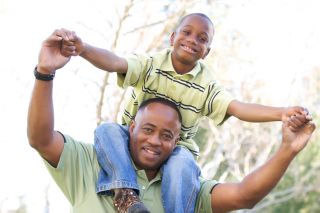
Fear
Facing Fears Without Pushing Your Child Over the Edge
How to help your child to gradually face fears
Posted May 30, 2014
I recently saw a viral video of a father pushing his 6 year old son over the edge of a skateboarding ramp. The response to this video has largely been negative and the father reported that he lost his job over this. The assumption is that the father was trying to help his son to get over his fear of dropping so quickly down the ramp--a good intention that was carried out in the potentially dangerous behavior of pushing the child over the edge of the ramp against the child's will and when the child was not expecting it.

Credit: spiritualhealingsource.com/wp-content/uploads/2012/09/Looking-down-from-a-tall-building.jpg
As parents, we've all been in situations where our child is terrified of something and we want to try to help our child to get over the fear so he/she can enjoy an activity. And as a specialist in anxiety, I can say that facing one's fears is the best way to go, but there are ways to do it that make the experience less scary and avoid pushing the child over the edge (both literatlly and figuratively).
1) When possible, gradual is best.
There are some situations where it would be tough to take a gradual approach to facing a fear, but in most situations, a gradual approach makes it much easier for a child to face a fear without feeling overwhelmed by anxiety. When you approach a feared situation, your fight or flight response kicks in. But often the level of anxiety that is experienced is in proportion to the situation. For example, if a child is afraid of a person dressed up like Cookie Monster, how close the child is to Cookie Monster will have an influence on the level of fear. If she is 10 feet away from Cookie Monster there is some low level fear. Being right next to Cookie Monster would lead to an extreme level of fear. The anxiety will go down as the body "puts the brake" on the fight or flight response. This can take 20-30 minutes sometimes but it will happen because it is an automatic response in the body. What's important is to start with less anxiety provoking situations so the child will stay in the situation to learn that his/her anxiety will go down and will gain a sense of mastery over the anxiety.
So find a way to gradually expose the child to the feared situation. When it comes to something like a skateboarding ramp, maybe there are varying heights of skateboarding ramps or varying levels of the ramp being steep. So start with the child exposing himself to less steep, lower ramps first and work your way up to a high, steep one very gradually.
2) Move at the child's pace.

You NEVER want to force a child to face a fear. Coaxing and encouraging are okay, but forcing is not okay. You want the child to feel like he or she is in control and to gain a sense of mastery. The best way to do that is to leave the child in the driver's seat. Ask the child if he/she wants to try something a little more difficult/anxiety provoking and encourage the child to be brave and face his/her fears. Make it clear that you will be there with the child to ride out the anxiety that the child will experience. You want the child to feel like you are a team and that the child isn't alone in riding out the anxiety. Pushing a child too quickly or forcing a child to face a fear against the child's will leads the child to experience a sense of distrust of you, which may lead to the child's anxiety being even greater as the child now feels that he/she is entirely alone and cannot trust you to help him/her.
3) Encourage the child for being brave.
The best way to help a chlid to face his/her fears is to provide encouragement. Tell the child that the child can be brave and give examples of brave characters in the child's favorite books, tv shows, and

movies. Superheros are bravve because they do things that are scary and yet they still do them. Many princesses are also brave, such as Rapunzel in "Tangled" when she leaves her tower despite being a bit nervous about it.
When the child is about to face his/her fear, tell the child that you know that the child can do it. But also make it clear that you aren't going to pressure the child. Then during the time when the child is facing his/her fear, make encouraging statements like "You're doing it!" "Good job!" "You're being so brave!" "I am so proud of you for being so brave!" Then reward the child for facing his/her fears after the fact. This may involve giving the kid a reward like a sticker or a treat or just giving the chlid a high-five.
4) Do NOT punish the child if the child backs away from the fear and will not face it.
I have talked with many parents who thought that their child was being "difficult" or defiant by refusing to face an anxiety-provoking object. The child is usually not trying to defy you or be difficult but is responding to his/her internal experience of overwhelming terror. Punishment really does not work in this situation. What it does is make an already difficult situation worse. The child is already overwhelmed and needs your support to help the child to get through the anxiety. If you punish the child, the child feels more isolated and the child is stuck between a rock and a hard place. The child either has to face terror or be punished. It is okay for a child to refuse to face a fear. That just means that the child isn't ready to face that fear on that particular day. Instead, find a fear that the child can face using the idea of gradually facing one's fears. If the child can't jump into the deep end of the swimming pool today, maybe the child can jump into the shallow end. Or maybe the child can hold start swimming in the shallow end and move even three inches farther into the deep end. Any progress that it made, no matter how small, is a victory and should be celebrated.
5) Patience and persistence are key.

Today may not be the day when the child goes down the high skateboarding ramp. That's okay. But maybe tomorrow is that day...or the day after that might be the day. You want the child to know that you will keep trying time after time and that it's perfectly okay not to tackle the most anxiety-provoking situation today. My favorite thing to say to kids is "No big deal! There's always another chance tomorrow or the next day." This conveys to the child that I will not give up on him or her, that I am not disappointed in the child, and that I'm going to be there on whatever day is the day when the child faces that fear. Your child may fail at something a hundred times before succeeding at it. You want your child to know that you'll be there for each failure and the ultimate success.
6) Empathy goes a long way.
You may not share your child's fears but they are very real to your child and should not be minimized. You also likely have fears that are not shared by others. For some people, the idea of jumping out of a plane is terrifying. For other people, it is an enjoyable activity. If you minimize the child's fears and say things like "Don't be such a baby," that is not helping the child. It is mocking the child for his/her fears and ultimately the child will not want to confide in you about his/her fears if he/she is mocked. Instead, calmly say things like "I understand that you are scared. That's okay. I get scared of stuff sometimes too. What's important is not to let being scared guide your life or limit what things you can do." Simply validing that your child is afraid can help your child to feel less alone in the experience. For more about talking to your child about his/her emotions see: http://www.psychologytoday.com/blog/dont-worry-mom/201311/finding-your-…
7) Seek help from a professional if you need it.

If your child's fears are guiding his/her life or interfering in your child's ability to do things that he/she wants to do, find a therapist who specializes in anxiety and who does cognitive-behavioral therapy. This type of therapy helps children to face their fears in a gradual manner and teaches ways to manage anxiety.
This website provides a great therapist finder: http://www.adaa.org/netforum/findatherapist
As does this one: http://www.abctcentral.org/xFAT/
For more information about handling child anxiety and stress see: http://www.psychologytoday.com/blog/dont-worry-mom/201302/12-tips-reduc…
Copyright Amy Przeworski. This post and all portions of this post may NOT be duplicated or posted elsewhere (including on other websites) without permission of the author. However, a link to this post may be posted on your website without the need to request permission.
Pictures from stock.xchng.
Follow me on Twitter @AmyPrzeworski https://twitter.com/AmyPrzeworski
Like my Facebook page: https://www.facebook.com/DrAmyP
Follow me on Pinterest: http://pinterest.com/amyp100/



